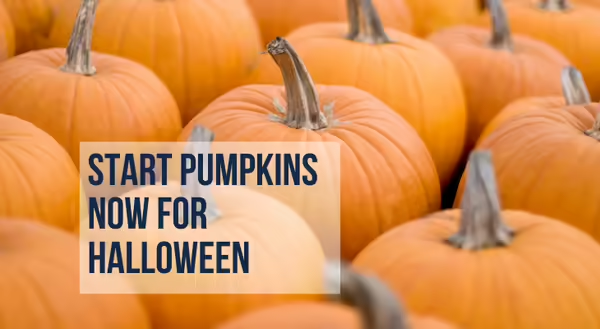
Why are we talking about pumpkins in June? Because if you want home-grown pumpkins for Halloween, it is best to get them planted now!
Good Growing Fact
Did you know Illinois is ranked #1 for pumpkin production with more than 10,000 acres planted in 2019? Morton, IL, is considered the Pumpkin Capital of the World because 85% of the world’s canned pumpkin is packed there.
How to grow pumpkins
Pumpkins are warm weather-loving vegetables that must be planted after all chances of frost. The traditional Jack-O-Lantern pumpkins take about 110 days to mature, so it is important to plant them at the right time to ensure pumpkins for Halloween.
Planting pumpkins
Pumpkins are commonly grown in hills as this allows the soil to warm up faster and drain better. Pumpkins are space-consuming plants with long vines taking up to 50 to 100 square feet per hill. For those with limited space, there are also short-vine variety (2 feet between hills; 6 feet between rows) or bush (3 feet between hills; 4 to 5 feet between rows) plants.
Plants can be direct-seeded or transplanted in late spring when soil temperatures have reached at least 70°F and frost has passed.
Growing pumpkins
- Weeding and Watering: Keep the growing area weed-free with irrigation during extended dry periods.
- Pests: Common insect pests we see with pumpkins include cucumber beetles and squash bugs. Insects play an important part in pollinating pumpkins; therefore, insecticides should only be used if it is truly necessary. If needed, insecticides should be applied late afternoon or early evening when blossoms are closed, and bees are no longer present for the day. Row cover can also be used to help control pest insects; however, this will also keep pollinators out, so it is necessary to remove the cover as the plants start to flower.
- Diseases: Powdery mildew is a common disease seen with pumpkins which can be identified as a white, powdery mold growth on the upper surfaces of the leaves.
Harvesting pumpkins
Come this fall, it is best to harvest pumpkins when they have reached a deep, solid color and the rind is hard. Clip fruit stems close to the vine to allow for a handle, but avoid picking pumpkins up by the handle to prevent damage to the skin/rind, and pumpkins without stems do not keep well.
Storage: To keep the pumpkins in good condition for Halloween, curing is recommended which can be done in the field for 5-7 days or indoors at 80-85°F and 75% to 85% relative humidity. White varieties should be cured indoors to prevent yellowing of the skin.
With a little bit of forward planning, you can have pumpkins to enjoy this fall! Or if you’re like me, you’ll leave the pumpkin growing to the pros.
Want to get notified when new Good Growing posts are available? SIGN ME UP!